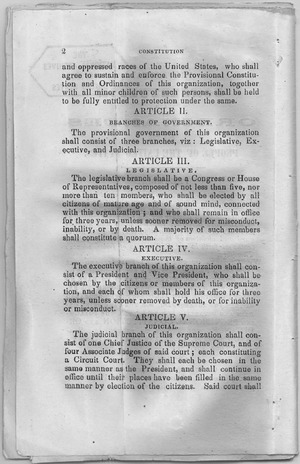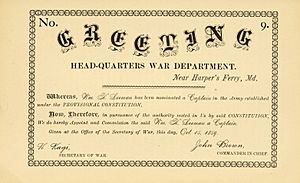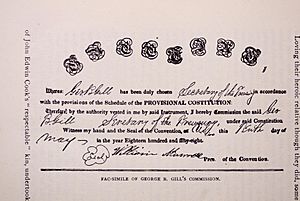John Brown's Provisional Constitution facts for kids
John Brown was an important figure in American history who fought against slavery. After his 1859 raid on Harpers Ferry, Virginia, many copies of a special document called a provisional constitution were found among his papers. This document suggested creating a new state in the Appalachian Mountains. This new state would be a safe place for escaped slaves who had fled from plantations.
Around the same time, John Brown also wrote a "Declaration of Liberty." This document was inspired by the U.S. Declaration of Independence, which declared America's freedom from British rule.
Creating John Brown's Constitution
John Brown wrote his Provisional Constitution and Ordinances for the People of the United States in February 1858. He was staying at the home of Frederick Douglass, a famous abolitionist, in Rochester, New York. Brown later said he created the document himself.
This constitution was officially adopted at a meeting Brown held in Chatham, Ontario, Canada. This meeting took place from May 8 to May 10, 1858.
Some people at the time thought this document showed that Brown was not thinking clearly. However, historians point out that the U.S. Constitution itself was a topic of much debate back then. Many abolitionists, like William Lloyd Garrison and Wendell Phillips, strongly disliked the U.S. Constitution. They felt it supported slavery, especially after the Dred Scott decision confirmed that enslaved people were not considered citizens.
What Was the Constitution For?
It's not entirely clear what John Brown planned to do with his provisional constitution. He didn't hand out copies at Harpers Ferry, and there are no records of him explaining how or when it should be used. John Brown often kept his full plans secret, even from his closest followers. People around him often had different ideas about what he was trying to achieve.
Under this provisional constitution, there would be a single legislative body, like a parliament, with 5 to 10 members. There would be no separate senate.
Brown did not believe that setting up a different government with a new constitution was an act of rebellion against the United States. He seemed to want the same United States, but with a constitution that was better and against slavery. The word "provisional" means temporary, suggesting he planned for a more permanent constitution later.
Some people were named as officers under Brown's Provisional Constitution. These included:
- William Leeman, who was named Captain on October 15, 1859.
- George B. Gill, who was named Secretary of the Treasury.
- Jeremiah G. Anderson, who was named Captain on October 1, 1859.
During his trial, Brown denied that he intended to create a new country or rebel against the United States government.
Why Was the Constitution Not Used?
None of the copies of the provisional constitution were ever given out. Even enslaved people living nearby did not receive copies. The reason for this has never been fully explained.
After John Brown was arrested, parts of his constitution were printed in many newspapers, like the Wheeling Daily Intelligencer. However, Brown was not asked about it by the many visitors he saw before his execution.
A document was found in the pocket of William H. Leeman, one of Brown's followers who died at Harpers Ferry. It was a commission naming him a captain "in the army established under the provisional constitution." This document was signed by John Brown, who called himself "Commander in Chief." It was dated October 15 and came from the "War Department, near Harpers Ferry." The commission was a pre-printed form, with Leeman's name filled in by hand.




